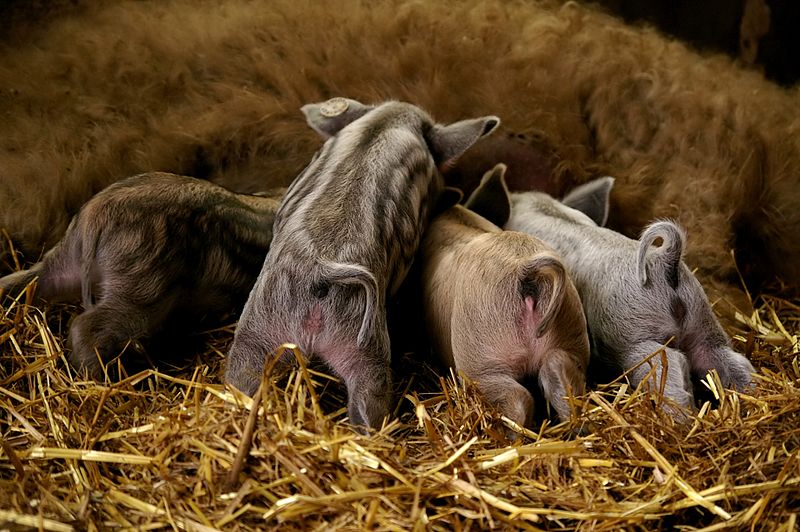Things have been pretty tense on Michigan’s small pig farms over the past few days. Farmers who own rare heritage pigs in particular have been waiting anxiously, hoping the state’s Department of Natural Resources (DNR) doesn’t show up to arrest them — or even kill their pigs.
As of April 1, the Michigan DNR was slated to start enforcing an order put in place last fall that classified wild boars as an invasive species. What does it have to do with farmers? It turns out the classification — which is based on a set of physical characteristics, such as straight ears, dark snouts, and a tendency toward stripes in their young — also includes many of the heritage animals kept on farms in the state. (Many farmers in the area raise an extra-fatty specialty breed called Mangalitsa, but they tend to cross them with heartier European hogs so they can withstand the cold Michigan winters).
Invasive wild boars have devastated many Southern states, so in a lot of ways the order has been an easy sell to some Michigan residents. Apparently 340 feral swine had been counted roaming in 72 of the state’s 83 counties. But most of those are thought to have escaped from the state’s wild game ranches — fenced-off areas populated with wild game for recreational hunting — not small farms. And farmers are making the point that pigs are smart animals; once they’re domesticated it’s very unlikely that they’ll ever leave a regular source of food.
When a bill that would have regulated the hunting ranches in the state legislature was stalled last year, the Michigan Pork Producers Association (who claim the presence of wild boar threatens their industry) stepped in to lobby for the invasive species order.
Farmers in the area are outraged. Mark Baker, of Baker’s Green Acres, makes his sole living off his farm, and has been especially outspoken on the issue. He’s filed a lawsuit against the DNR in hopes of getting a temporary stay against the order. In this video, which has been watched over 50,000 times (see below), he can be seen defending his animals and drawing a direct link between the invasive species order and the Michigan pork lobby. “The people who grow pigs in confinement … those are the guys who don’t want guys like me growing pigs out in the dirt. And they’ve employed the DNR to come after us, and they’ve said that our pigs spread disease when they go feral. They have this notion that our pigs are scratcing at the fence waiting to get away.”
The day after the order went into effect, a friend of Baker’s wrote on his blog:
We spent a very long day on Sunday waiting to hear trucks come down the dirt road in front of Mark’s house. Mark, Jill, the children and a few friends that Mark wanted to have with him, if the situation unfolded and the DNR came to kill his pigs.
Like Baker, Stuart Kunkle of Bricolage Farm says he’s keeping his pigs, even if it makes him a felon.
“Almost all of my pigs have some characteristics that put me in violation,” he says. But he’s willing to get arrested rather than end the lives of the animals he’s been raising, which include a heritage breed called a Mulefoot that also happens to be “the rarest swine in America” (as in, ahem, they are deserving of preservation — pretty much the exact opposite of invasive).
Kunkle is aware that many raw-milk advocates, known for their single-minded focus, have allied themselves with his cause and have also been spreading about the invasive species order, calling it “a war on family pig farmers” that will involve hundreds of arrests of ranchers. That might sound typically alarmist, but he believes they might actually be hitting closer to the mark than usual.
“It’s kind of like the raw milk issue, but it takes it a little further,” he says. “This isn’t just talking about a fringe product that people may or may not have a feeling about, this gets a little closer to the heart of something. Whether you eat pork or not, if you look at how these animals are raised — and typically it’s way better than their CAFO counterpart — you can quickly gain some kind of sympathy about this.”

Striped coloration on young pigs is one characteristic that could qualify them as invasive species in Michigan. (Photo by Norro.)
Around 2,000 farmers in Michigan have 500 or fewer animals, and many have much fewer. Don Coe, a member of the state’s Commission on Agriculture, raises just two Mangalitsa mixes a year. Coe was watching closely as a bill to control the state’s hunting ranches moved through both the house and senate before stalling when the pork industry got involved.
“Michigan Pork had brought Michigan soy and corn producers to the table to say they didn’t want to see hunting ranches regulated, they wanted to see the invasive species order,” he recalls. “So they went around the commission on agriculture.”
In a recent post on Take Part, Clare Leschin-Hoar spoke with Sam Hines, executive vice president of the Michigan Pork Producers Association, who fully admits that his organization, and the massive industry they represent, is involved in the order. Leschin-Hoar writes:
Hines says they’ve trapped a number of feral pigs and have tested them for diseases, including pseudorabies.
“It’s not something that humans would get, but it’s devastating to some species of livestock. If that virus gets disseminated to the domestic or commercial swine herd in this state, we would become quarantined. It would be economically devastating to our producers,” he said.
But so far, he admits, the transfer of pseudorabies from feral pigs to domesticated hogs has not occurred.
Coe, who runs a CSA and an inn, and has started a small charcuterie business with the meat from the pigs he raises, considers himself a moderate voice on the issue and hopes the two sides can come to an agreement. “The local food movement is growing in this area; let’s do what we can not to turn Big Ag and small ag against each other,” he says. Coe and other farmers he knows are willing to pay a fee to keep their pigs, and he’d even consider putting a microchip in their ears, like pet owners do with dogs and cats.
But Kunkle feels that paying a fine to raise his animals or have them implanted with microchips would be a form of surrender to the Michigan DNR and the corporate forces behind it.
“That doesn’t address the real issue,” he says. “I don’t think there’s anything wrong with the pigs we’re growing.”
Ultimately, Coe also recognizes the larger systematic problems at work in his state. “The answer in my mind is not to give the DNR the authority to declare various animals invasive or ban them,” he says. “What’s the next breed they’re going to go after? Llamas? Some special breed of heritage turkeys? This whole thing has been driven by special interest.”
Coe adds that the state has a deer problem the DNR has yet to solve.“If you’re so concerned about an animal causing damage, then why do we have 67,000 deer/car collisions in this state a year? DNR’s job is to manage animals in the wild and the Department of Agriculture’s is to manage animals on farms.”
Now, four days after the order took effect, it’s unclear whether any pigs have actually been killed or removed from farms.
Ed Golder, spokesman for the Michigan DNR, told a reporter from Michigan Live, “Our hope is to be invited onto farms voluntarily,” where they could inspect pigs and ask farmers to “handle the depopulation on their own.” Which makes you wonder: Has he met many of today’s small farmers? Someone who has gone through the work to raise a rare breed of pig on pasture isn’t likely to give the animal up without a fight.
But one thing is clear: Many outside Michigan are keeping an eye on the situation, including officials from states looking to follow suit — like Pennsylvania, Kansas, and New York. As Mark Baker says in the video below, “There are 10 other states watching what Michigan does, and if Michigan gets away with this and they’re able to declare that one of my farm animals is an invasive species and therefore outlawed, where does it end?”





